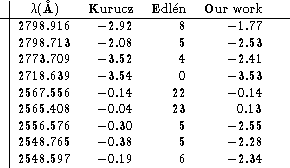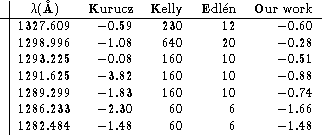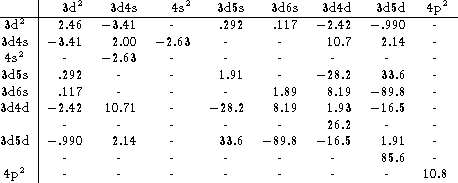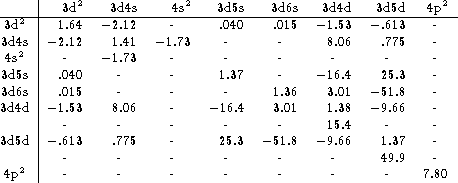Although the orthogonal operator method is known to describe energy levels of complex spectra more accurately (by an order of magnitude) than earlier methods, a similar claim for transition probabilities has yet to be proved. However, the transition probabilities of the present pilot cases Ti III and V IV sustain the comparison with the available experimental data successfully. Global agreement with the database of Kurucz (1993) has been found, while discrepancies seem to be in favour of the present calculation.
To avoid typing errors, all tables containing transition probabilities are computer
processed. The only stage in which data typing by hand occurs is in the input of
the energy fitting program. However, due to the low mean error ![]() of the fit
with orthogonal operators, the levels values are scrutinized almost automatically.
of the fit
with orthogonal operators, the levels values are scrutinized almost automatically.
Complete results of the fits of both the odd and even energy system, as well as the corresponding complete transition arrays can be found in our database (anonymous ftp) at ftp://nucleus.phys.uva.nl in the directory pub/orth/ti3.
Acknowledgements
It is a pleasure to thank Dr. Biémont and Dr. Henrichs for fruitful discussions on the astrophysical relevance of this work.
Table 3:
Calculated log (gf) values for the (![]() transition array of Ti III
transition array of Ti III
Table 3: continued
Table 4: Calculated log (gf) values for the ![]() - 3d4p
transition array of V IV
- 3d4p
transition array of V IV
Table 9:
Calculated A-values for the
Table 10:
Calculated A-values for the
Table 4: continued

Table 5:
Examples of differences for some ![]() transitions in
Ti III between log gf data obtained
by our method and Kurucz data base compared to
experimental intensity numbers by Edlén
transitions in
Ti III between log gf data obtained
by our method and Kurucz data base compared to
experimental intensity numbers by Edlén

Table 6:
Examples of differences for some ![]() transitions in
Ti III between log gf data obtained
by our method and Kurucz data base compared to
experimental intensity numbers by Edlén
transitions in
Ti III between log gf data obtained
by our method and Kurucz data base compared to
experimental intensity numbers by Edlén

Table 7:
Values for the electric quadrupole transition integrals
in Ti III calculated by means of MCDF including core polarization

Table 8:
Values for the electric quadrupole transition integrals
in V IV calculated by means of MCDF including core polarization
![]() M1 and E2 transition arrays of Ti III; the notation x(y) means
M1 and E2 transition arrays of Ti III; the notation x(y) means
![]()
![]() M1 and E2 transition arrays of V IV; the notation x(y) means
M1 and E2 transition arrays of V IV; the notation x(y) means
![]()
![]()
![]()
Up: Orthogonal operator calculation